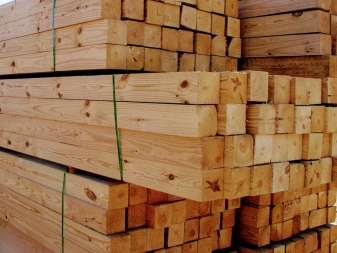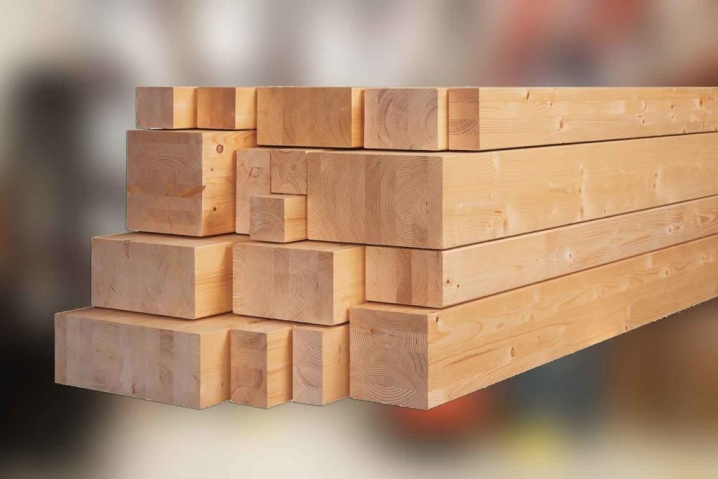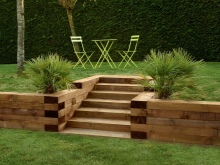All about the timber

Questions about timber regularly arise from novice builders or home craftsmen who want to work independently with wood. It is important for them to find out how it differs from other lumber, what it is, how strong and durable it is. To understand the features of a calibrated or round impregnated bar, you should study the standards of GOSTs, and also consider all of its main characteristics in more detail.

What it is?
Among the varieties of lumber, timber can be called the most popular option used in construction to create load-bearing structures. Its production is regulated by the requirements of GOST 18288-87, GOST 22454-80, GOST 2695-83. This category includes lumber with a width and thickness of at least 100 mm. A bar is made on sawmills by cutting 2, 3 or 4 edges from an array of wood with dissolution according to specified dimensions. Standard section - rectangular or square, providing maximum strength, resistance to various types of loads.


The distinctive features of the timber include widespread use - it is used as supporting elements, as well as as an independent building material. Careful surface treatment keeps subsequent operations to a minimum.
The timber is easily sawn to the specified dimensions with improvised means - hand, electric, gasoline-powered tools.




The timber has obvious advantages that distinguish it from other materials.
- Affordable cost. The most budgetary solution will be the classic type of timber, which has natural moisture. The rest of the options will cost more.
- Ease of installation. The processed lumber fits well in the horizontal and vertical planes. Buildings from it are assembled and built in a few weeks.
- Unified dimensional parameters. The profile and length are standardized, which greatly facilitates the calculation during construction.
- Timber production is widespread, it is easy to find and purchase in any region.
- Low load on the foundation. You can build a light foundation, build on heaving soils.
- Attractive appearance. High-quality profiled or glued timber does not require additional finishing.

There are also disadvantages. Inexpensive varieties of naturally dried timber give impressive shrinkage, which is completely completed only after 1-2 years. Non-glued material will crack over time. Its flammability is also quite high, the surface requires additional protection with impregnations.
In addition, the material is quite heavy, so it is almost impossible to build from it alone.

Views
The timber is quite varied in size and characteristics. It can be calibrated and spliced, structural and impregnated, perforated and brushed, non-planed and polished. Each species has a differentiation into varieties, as well as a certain set of characteristics. For the manufacture of material, round timber is opened from coniferous or deciduous wood, and mainly from winter harvesting.

Regardless of the classification, the timber completely retains the texture of wooden surfaces. The range is determined by the requirements of GOST, they also indicate the types of connections. According to them, lumber is divided into:
- two-piece;
- three-piece;
- four-edged.



Considering all these points, we can proceed to the consideration of the basic classification of the timber. It is she who determines the purpose of the material, the scope of its use and basic properties.

Whole
Wooden beams with flat planed edges are one of the most common types of lumber. Its edges are semicircular, the standard section is square. Such lumber is also called standard, it can have a planed surface or remain untreated.
They dry solid timber from solid wood in conditions of natural humidity, so the whole process takes quite a long time.

Standard lumber is not well suited to tough construction tasks. Most often it is used as a basis for creating simple structures for household purposes. Such a beam is used for the construction of the foundation strapping, the construction of gazebos, pergolas.



The features of the whole variety include the following series of points.
- The presence of pronounced shrinkage. Over time, wood can crack, warp, and decrease in volume.
- The need for additional insulation. Since the material changes its geometry after installation, gaps form between adjacent elements over time, causing heat loss. The problem can be eliminated only by additional insulation and sealing of the structure.
- The need for finishing. Finishing of the surface of the timber is not performed, therefore it is necessary to additionally cover it with paints and varnishes.
- Demanding on the strength of the structure. Bearing elements and corners made of timber must be additionally strengthened.

In general, a standard timber of natural moisture can be called a universal material. If you initially take into account its features, you can easily carry out construction work during the construction of capital and temporary structures.

Profiled
The profiled timber made of solid wood undergoes processing on the machine, which provides it with precise geometric parameters, smoothness and visual appeal. Sometimes an already antiseptic material is produced, treated with special impregnations against mold and rot.
When assembling structures from a profiled bar, the seamless “thorn-groove” (or “comb”) technology is used, which allows joining adjacent elements as tightly as possible, without gaps.

Lumber of this type is made from logs pre-dried to a moisture content of no more than 22%. This allows for further machining not to be afraid of changes in the geometric characteristics of the material. Depending on what type of connection is used, additional insulation can be used - it is possible if the crowns are joined using the “thorn-groove” technology.

Although profiled beams are valued above solid wood, they do not differ too much in their characteristics from other solid wood lumber. Defects and defects of wood may be present in some elements.
In addition, the timber may shrink slightly during the drying process.

Glued
Selected material, free from defects. In the production of laminated veneer lumber, individual elements are combined with each other, forming a product with a calibrated cross-section without knots and cracks. This sawn timber is subjected to compression and high temperature exposure during production.

It is characterized by the following distinctive features.
- Constant geometric parameters. The material does not shrink during construction, so a house from it can be immediately finished and arranged.
- Comb or spike joint. It allows you to avoid heat loss, ensures a tighter fit of the elements to each other.
- Flat edges or D-profile. The second option allows you to give the wall surface the appearance of a log building, since one of the four sides remains rounded.
- No need for decorative finishes. It is enough to cover the material with protective impregnations.


Glued laminated timber is sold at a much higher price than its solid wood counterparts. The use of compounds, with the help of which small bars are turned into a full-fledged product, makes the material less environmentally friendly. It is worth making sure in advance that the glue used meets safety requirements.
In addition, buildings made of such a bar do not retain the ability to natural ventilation, therefore, it must be created forcibly.

LVL
LVL beams are manufactured using a technology similar to that used in the production of the glued variety. True, the raw materials are used differently. At the heart of such a bar is a veneer with a thickness of 3 mm, connected in layers to the desired size. The texture of its surface is decorative. When gluing, the veneer layers are placed parallel to each other so that the direction of the fibers in them coincides.

LVL timber is a rather expensive material used for finishing buildings and structures, the formation of external and internal walls, partitions. Due to the multilayer structure, it acquires increased strength and flexibility. Such a product does not have defects typical for solid sawn timber.

Materials (edit)
In the manufacture of glued and solid timber, coniferous and deciduous species of wood are used. In this case, a good building material must have a high density, hardness, and withstand significant loads.

The main types of wood suitable for creating a bar should be considered in more detail.
- Beech. Products made from it are distinguished by their high cost. At the same time, beech wood is beautiful in appearance, very dense and hard. The main application of the material is interior decoration, construction of supports for stairs and other structures.

- Cedar. It should be noted that this valuable wood species is rarely used in construction. A house or a cedar bath will cost a fortune. Here cedar pine is used - a more common tree with a strong and dense structure, beautiful texture.

- Aspen. Wood of this species is characterized by a tendency to warping; when dried, it shrinks quite strongly. Otherwise, the aspen beam has practically no drawbacks. It is durable, strong, and decay resistant.

- Birch. A deciduous tree species characterized by strong warpage and a tendency to cracking. For large-scale capital construction, birch timber is not used, since it is characterized by intensive absorption of moisture and a tendency to decay.

- Maple. This wood species has a beautiful cut texture and high fiber density. Maple timber is not a cheap material, it is most often found among glued varieties.

- Ash. High class material. Most commonly available as a glued variety. Dense wood does not emit resin, as is the case with conifers, is durable, withstands rather high operating loads.

- Spruce. The most demanded material for the manufacture of timber, as it has sufficient density and relatively low weight. Spruce wood is well suited for the construction of baths, residential and country houses, has good thermal insulation characteristics. The disadvantages include resinousness, susceptibility to decay.

- Linden. Its wood is soft, subject to decay and other biological factors, and is prone to significant warping. Linden timber is not used in the creation of houses, but can be used in the construction of baths, their interior decoration. The material is lightweight, easy to process.

- Pine. The second most popular material in the production of timber. It is more resinous than spruce, so it is not suitable for building baths. This option is suitable for the construction of cold buildings that are not used in winter.
The pine is more knotty, and you should pay special attention to the grade of this lumber.

Finnish (Scandinavian) design often requires the use of materials that imitate natural timber in the interior, for example, in the form of beams, supports. It uses a wood-polymer composite (WPC), which is lighter but stronger and has a constant geometry.

Connection types
The assembly of structures from a bar involves the formation of connections of elements among themselves - at the corners and in a straight line, with a different section. In the horizontal plane, installation can be carried out by connecting the sides with grooves and tenons.



In addition, the following types of compounds are distinguished.
With the remainder
This method is used for one-sided joining of materials. On one side of the timber, a notch is made - a cut along the width of the attached element. The cut is always on the cross section. This is a good solution if you are not using ordinary material, but a carriage with two cut flat edges.

The connection with the remainder can also be two-way. In this case, cuts are made on the upper and lower parts of the bar (opposite each other). The sampling depth should be up to 1/4 of the entire thickness.
With a four-sided connection, cuts are made on all edges - strictly at right angles.


No residue
This type of connection has several options at once.
- Butt. This connection is carried out using metal plates with spikes. In this case, the elements themselves are fixed with staples, nails and other hardware. The butt joint eliminates the displacement and rotation of the bar.
- Into the thorn. These elements are triangular or trapezoidal. In the mating part of the joint, a groove of the same size and shape is formed. The parts are joined without unnecessary difficulties, they can be additionally laid with heat-insulating materials - felt, jute fiber.
These are the main connection options used when fixing the timber without residue.


Sizes and shapes
The classification of timber by size and shape is also of great importance. The most common options are listed below.
- Square. With this section, the size range varies from 100 to 250 mm. The square profile is quite popular in the production of solid planed timber.
- Semicircular (carriage, timber with a D-shaped profile). The round edge is usually placed outward, imitating log crowns.
- Rectangular. The best option for assembling structures that are not exposed to intense loads. Its width is always 50-100 mm greater than its thickness.



The standard bar size range starts from 100 mm. Products are produced with a step of about 5 cm. That is, for construction, you can choose options with a section of 100, 150, 200, 250 mm. Dimensions affect the reliability of the walls of buildings assembled from timber, determine the need for additional thermal insulation.

The thinnest beam of 100 mm is used for the construction of insulated buildings and structures. In this case, the difference of 50 mm is not too important, so you can take material with lower indicators without losing the reliability of the structure. For buildings without additional insulation with a comb connection of a bar, a thicker square-section material with parameters from 200 to 250 mm is taken.

Application
Construction timber is perhaps the most popular lumber. In its production, environmentally friendly raw materials are used, the processing of which can include not only sawing, but also grinding, as well as the application of protective impregnations.
The main directions of using the timber are quite obvious.
- Construction. Lumber of this type can be used for the construction of the frame or cladding of buildings and other structures. It all depends on the way they are processed. For building a house, he uses glued or profiled timber.

- Manufacturing of fences. To create the frame part of the fence, an ordinary solid bar is used, inexpensive and durable.


- Furniture manufacturing. Here the timber becomes part of the supporting or frame elements.

- In the interior. In the creation of the interior, the timber is used to cover large spaces. It is used to make load-bearing and decorative ceiling beams, wall beams, floor supports. Partially open partitions and bar counters from a bar also look attractive.

- Ship finish. Deck beams are used for laying wooden floors on ships for various purposes.

- Creation of large-sized containers. Containers and boxes with timber frame withstand the most intense loads.

The main directions in which the use of lumber of considerable thickness is most justified are listed. In addition, decorative and functional landscape elements are often created from timber - pergolas, gazebos, pavilions in the country, in a country estate.



How to choose?
The choice of a suitable bar for construction work requires a thorough study of all the features of its subsequent operation. Sometimes it is better to consider a margin of thickness or spend a little more money on materials to avoid possible problems.

Among the recommendations that will be useful to builders when choosing, the following points can be noted.
- Number of storeys of a building or structure. Square-section materials up to 150 mm thick are suitable for the construction of one-story buildings. For a two-story house, take a beam of 200 × 200 mm or more, which has higher bearing capacities and operational characteristics.
- Appointment. For a country house, buildings with a seasonal mode of operation, a timber of natural moisture, one-piece, untreated, is suitable. Residential buildings require quality materials for year-round use. Here they use chamber-dried glued laminated timber with a comb-shaped profiled joint.
- The quality of the material. The optimal range of timber for construction - A, AB. For outbuildings, gazebos, pergolas, material with a large number of defects is suitable. But you should not purchase products with pronounced curvature, cracks, and a large number of knots. A bluish bloom, dullness of wood testifies to its defeat by rot.
- Appearance. A beam with a D-shaped profile on one side (carriage) looks more aesthetically pleasing than the classic version with smooth and flat sides. It is used in residential construction, as well as where it is required to create an imitation of a log frame.
- Wood species. Choosing between coniferous and deciduous options, you can give preference to the first group. Pine and spruce, when using special impregnations, significantly increase their resistance to external factors. If you do not want to waste time and money on additional paintwork, then it is better to prefer larch, maple or ash.
- Seasonality of procurement. A bar from a log harvested in winter is more durable. Spring lumber is the wettest and requires chamber drying.
- Storage conditions. If the material was lying in the open air, it will be rather difficult to talk about the preservation of characteristics. It is better to choose timber at large construction bases or sawmills that have the resources for the correct storage of the supplied products.

Considering all these recommendations, you can choose a suitable wooden beam for construction work, decoration of buildings and structures.














The comment was sent successfully.